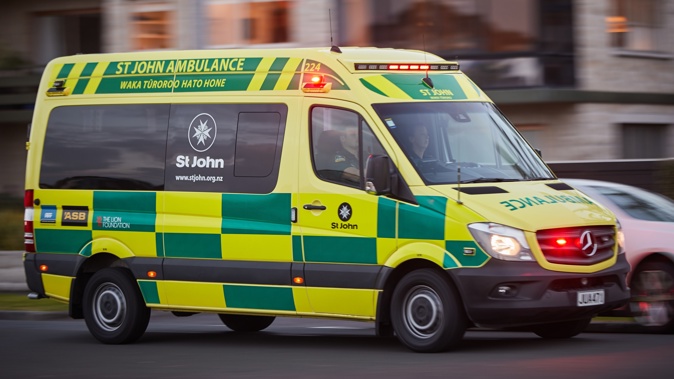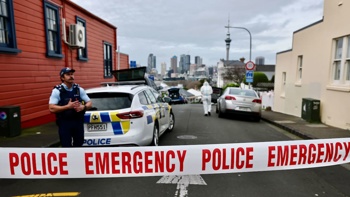
Hato Hone St John says it “unreservedly” apologises to the family of an elderly woman who died following a 70-minute wait for an ambulance.
A coroner has described the circumstances around Rangiora woman Margaret Elizabeth Lindsay Wells’ death as “deeply troubling”, saying that despite St John receiving a call concerning a life-threatening medical emergency, it took over an hour for paramedics to arrive “due to scarce ambulance resources and competing demands”.
The woman’s daughter told the Herald she’s “angry and upset” with St John about its response time.
“Not saying that mum would’ve survived, but she didn’t get a chance.”
On Friday afternoon, Hato Hone St John general manager of clinical effectiveness Jon Moores said it had accepted the coroner’s findings and “apologise unreservedly” to Wells’ family for “failing to deliver the appropriate standard of care and for the distress this may have caused”.
“We plan to reach out to the family to discuss the findings and share with them the steps we have taken since the incident occurred.”
Moores said ambulance resourcing contributed to what happened. In the four years since, Hato Hone St John has worked on increasing ambulance resources in the Canterbury district, including adding five new ambulances to the fleet in the last six months alone.
“We are currently working our way through the coroner’s findings, and we are committed to learning from the report’s recommendations so we provide our patients with the best level of care we can.”
Alfred and Margaret Wells. Margaret Wells died after waiting 70 minutes for an ambulance.
‘I think my wife is having a heart attack’
Coroner Mary-Anne Borrowdale’s report into Wells’ death was released to media on Thursday.
The report says Wells, 78, was living in Rangiora with her husband, Alfred.
Wells was in “good health” with no history of cardiac disease. Her husband was a double amputee.
In the days prior to September 20, 2020, she had told her husband she was having chest “palpitations”, and she made an appointment to see her GP on September 22.
About 2.45am on September 20 she went into her husband’s bedroom and woke him.
“She had vomited and was pale and sweating, with chest pains. She was holding her hands to her chest,” the report said.
She then asked her husband to call an ambulance.
“He quickly did so, and was very worried about her,” Coroner Borrowdale said.
Wells went back to bed with a basin, while her husband called emergency services.
“I think my wife is having a heart attack,” he told the call handler, adding “she is just lying there - doesn’t look very good at all”.
The call handler told him she was arranging help, and to stay on the phone. She told him not to give her any food or drink, and to let her rest in a comfortable position to wait for an ambulance. He was also told to watch her closely, and if things got worse to turn her on her side and call 111 back immediately.
While they waited her condition got worse.
At 3.40am, Wells’ husband called 111 again as no ambulance had arrived.
The call handler said the ambulance was about 5km away. He said his wife’s condition was “getting worse now”, and she was “nearly unconscious”.
“She’s not awake. I don’t think she is breathing,” he then said.
The call handler then started giving him resuscitation instructions, asking him to put her on the floor.
“Can I lay her flat on the bed? ... that’s going to be a problem, I’m a double amputee - I’ve got my legs on, it’s hard to lift anybody - she’s breathing, but not the best,” he replied.
The ambulance crew arrived at 3.46am. Wells was given CPR, defibrillation, cardiac monitoring, advanced airway control, and intravenous cannulation, but there was no heartbeat. She was pronounced dead about 4.20am.
An autopsy found she died from a heart attack due to severe ischaemic heart disease.
Coroner Borrowdale said the focus of Wells’ family and the inquiry was whether her lengthy wait for emergency services may have “caused or contributed to her death”.
St John has five colour categories used to prioritise calls. When Wells first called it was classified red 1 - meaning the incident appeared to be immediately life-threatening and an ambulance should be dispatched as soon as possible under lights and sirens. After the second call, it was reclassified purple - a suspected respiratory or cardiac arrest and an ambulance is to be immediately sent under lights and sirens.
St John’s clinical director, Dr Tony Smith, told the coroner that red 1 was the correct initial categorisation. Purple was reserved for patients whose heart had stopped beating.
“The patient who’s in cardiac arrest always has to take priority over a patient who’s having a heart attack but who’s not in cardiac arrest,” Dr Smith said.
‘We run out of ambulances’
On the evening of Wells’ death, there were 11 crewed ambulances rostered in Canterbury. Of the 11, one was in Kaiapoi, one in Rangiora, and seven in Christchurch.
When Wells’ husband first called all of the ambulances were responding to incidents and the amount of emergency incidents was double the average.
“Particularly at peak workload, we run out of ambulances. That’s what happened on this night,” Dr Smith said.
St John, which the coroner said was “largely government-funded”, has a provision of “timely and appropriate care and transport” by ambulances.
St John’s cardiac response data said that for every minute that went by without CPR or the use of a defibrillator, the chance of survival dropped by 10-15 per cent.
St John’s response time target for a red 1 call in a rural area was 50 per cent in 12 minutes and 95 per cent in 30 minutes.
Dr Smith told the coroner that peak demand, meaning “every ambulance is simultaneously attending to an emergency”, was hit every day in Christchurch and Auckland.
He added that in Canterbury, St John was not meeting its red urban or rural response targets and said it was a “significant area of concern”.
“We don’t have enough resource to respond to the total workload,” he said.
Coroner Borrowdale said “significant response-time improvements”, had been made by St John by 2022-23.
An adverse event review was carried out by St John. It found that ambulance “Christchurch 32″ was attending a lower-priority callout, but was not re-assigned to attend Wells. Just minutes after Wells’ husband called an ambulance in Amberley was assigned, but did not respond as there were no volunteers rostered that night.
At 2.55am, a “time critical incident notification” was sent to all ambulances at the hospital. At 3.22am, an ambulance that was en route to Wells’ home was reassigned to a higher priority call elsewhere.
Elderly woman’s survival chances halved by delays
Dr Smith said the failure by St John to assign “Christchurch 32″ to Wells was a “regrettable error and an adverse event”.
It was human error, through the pressure of work on a “very busy night in Canterbury, resourcing multiple incidents”.
He added a Clinical Support Officer (CSO) should have reviewed Wells’ call at about 3.20am, and called him back to check on her.
A request for a review was activated at 3.25am, but that had not occurred before the second call at 3.40am due to the workload in the communications centre.
Dr Smith “apologise[s] unreservedly for the failures associate with dispatching an ambulance”, to Wells, and for the resulting distress to her family.
Coroner Borrowdale said a “valuable treatment opportunity” between 3.15am and 3.40am was missed.
“Would such treatment have saved Mrs Wells? The answer is, possibly; the evidence is that Mrs Wells’ survival prospects were halved by the ambulance’s delayed arrival.”
Dr Smith said had Wells’ cardiac arrest after paramedics arrived, her predicted survival rate was 60 per cent. Her predicted survival rate without paramedics was 30 per cent.
Dr Smith told the coroner, “the delay has contributed to Mrs Wells’ death but has not caused it”. Coroner Borrowdale agreed.
The coroner commended St John on its “honest, self-appraisal, and its willingness to make significant changes to its practices”.
Among the actions taken was the call handler involved receiving post-incident re-training, a mandated requirement that each dispatcher use a function recommending in every case the nearest available ambulance, and requiring available volunteers to electronically log-in to indicate when they are available.
A funding increase had also allowed St John to recruit more trained call handlers, CSOs, and ambulance crew members.
Coroner Borrowdale made a number of comments directed to St John and said Wells’ death “occurred in circumstances that are deeply troubling”.
“The health, wellbeing and lives of New Zealanders depend on their ability to access emergency help in times of critical medical need.
“Communities expect and trust that emergency ambulance services will have the capacity to assist them quickly when they call for help. Increased ambulance waiting times increase the risk of patient death.”
Wells’ wait time “exceeds what is reasonable,” the coroner said.
“Mr Wells experienced a highly distressing hour waiting for an ambulance to attend to his wife who was, as he reported to St John, having a heart attack. Mr and Mrs Wells were elderly and alone, and Mr Wells was a double-amputee who was unable to effectively aid Mrs Wells in her medical emergency. They were each entitled to expect a quicker response from St John, notwithstanding that its operational capacity is frequently stretched to its limits.”
The coroner recommended St John continue its efforts to “develop and enlarge” standard call handler questions “to encompass gathering information about whether the caller has any impediment that would prevent them from assisting the patient while help is on the way”.
She also recommended that St John’s triage and priority system be adjusted to “allow for an increased priority where the patient is not able to receive essential bystander assistance from the caller and other attendees.”
‘She didn’t get a chance’
Wells’ daughter, Liz Wells, told the Herald she was “angry and upset” with St John about their response time.
“Not saying that mum would’ve survived, but she didn’t get a chance. Dad tried to save her but he’s a double amputee and he couldn’t do much. It was just the fact she didn’t have a chance.”
Reading the report she was upset that she could not be there to help the couple.
“They would’ve been so scared and he couldn’t do anything”.
She and her daughter had since moved in with her dad to look after him.
Wells said her mother was her “best friend”.
“The last thing she said to Dad was ‘I don’t want to die, please don’t let me die’. She lived for her grandkids, she never got to see her great-grandaughter. She’s missing out on my daughter growing up ...
“Mum just lived for life, she loved her grandkids.”
Wells was “disturbed” that the dispatcher pulled an ambulance away that was en route to her mother.
She said her father “has his up and down days,” and believes he blames himself that he could not save his wife.
The couple, who had been together since they were teenagers were “like best friends”.
Wells said she had not heard from St John and that the family had not received an apology from St John. She believes her father should be entitled to compensation.
“It’s like we’ve just been brushed under the table - you’re just a number.”
This story was originally published on the Herald, here
Take your Radio, Podcasts and Music with you









